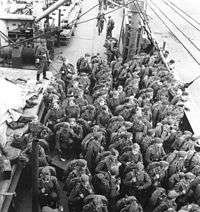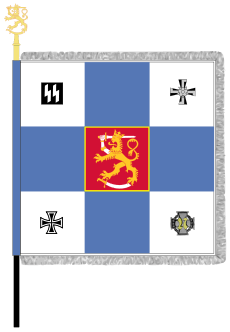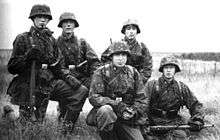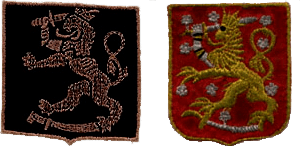Finnish Volunteer Battalion of the Waffen-SS
| Finnish Volunteer Battalion of the Waffen-SS (SS Volunteer Battalion Nordost) | |
|---|---|
|
Arm badges of Finnish Waffen-SS | |
| Active | 1941 – July 1943 |
| Country |
|
| Branch | Waffen SS |
| Size | 1408 volunteers (in all)[1] |
| Commanders | |
| Notable commanders | Hans Collani |

The Finnisches Freiwilligen-Bataillon der Waffen-SS was a Finnish volunteer combat battalion of the German Waffen-SS. It saw action on the Eastern Front during World War II.
Formed in 1941 as SS Freiwilligen-Battalion Nordost, the battalion was made up of 1,200 Finnish volunteers who had signed to fight against the Soviet Union for two years. While many Finns were already serving with the SS-Division Wiking, the battalion differed in that it was staffed with Finnish officers and NCOs (Wiking being commanded by Germans).
The mathematician Rolf Nevanlinna was chairman of the Committee for the Finnish Volunteer Battalion of the Waffen-SS.[2]
The unit lost 255 men killed in action, 686 wounded and 14 missing during its service.[3]
The battalion was praised by many Waffen-SS commanders, even Heinrich Himmler, for its combat performance. Himmler said "Where a Finnish SS-man stood, the enemy was always defeated."[4] Neither the unit nor any of its members were ever accused of any war crimes.[5]
Initial recruitment
After the Polish campaign, Reichsführer-SS Heinrich Himmler sought to expand the Waffen-SS with foreign military volunteers for the "crusade against Bolshevism". It has also been widely speculated that Himmler sought to eventually replace the Heer (regular army) with his own Waffen-SS, and with German manpower drained by conscription, Himmler was forced to look outside German borders to find men for his semi-private army. However, during the war, all Waffen-SS formations served under the Heer command.
As part of Himmler's efforts to raise men, the first SS multinational division was created. Originally called Nordische Division (Nr. 5), it was intended to be made up of German Waffen-SS personnel and Dutch, Danish, and Norwegian volunteers. The division was renamed "Wiking" (see main article for more details), and its main combat strength was three SS Panzer grenadier regiments: Germania, Westland and Nordland.

In December 1940 SS headquarters was in touch with the Finnish government as part of military negotiations with Finland. They had strongly suggested that the Finns should show their allegiance to Germany by sending volunteers to the German armed forces. There was an historical precedent for a battalion of Finnish volunteers had signed up with the German Army during the First World War, when Finland was still a part of Russia. They had formed the 27. Jaeger Battalion of the German Army and fought on the Eastern Front.
The Finnish government agreed to the plan, both to demonstrate their allegiance to Germany and to gain a concrete assurance of their alliance. Suggestively, the definitive Finnish academic study on the battalion is called "Panttipataljoona", or "Pawn battalion". The Finnish foreign ministry ordered the former chief of Finland's secret police, Esko Riekki, to carry out recruiting for the battalion in secret.
At Riekki's insistence, the men were recruited from a wider range of volunteers instead of only right-wing extremists and Nazi sympathisers. The recruits were screened for racial suitability; requirements included a minimum height of 170 cm, good teeth, age 17–23 years and satisfactorily answering a questionnaire with such items as whether the recruit was of "Aryan birth" or not.
Despite the Finnish government's attempts to recruit from a wide range of political opinions, some 20 percent of the men had extreme right-wing affiliations. Approximately 80 percent were or had been members of Finnish Suojeluskunta self-protection militia (which was non-socialist and anti-Bolshevik).
The recruits included 10 regular officers, 66 reserve officers and 29 non-commissioned officers. This was many more officers than were necessary for a single battalion, and the German government suggested to Finland that if some 1,000 more men were recruited, the whole force could be used to form its own SS regiment, with Finnish officers. The Finnish government rejected the idea.
Service in the Waffen-SS

Four-hundred of the volunteers had previous military experience from the Winter War, and they were assigned directly to the Wiking division. They are known in Finnish literature as the "division's men", and were assigned to both the Nordland and Westland regiments, as well as to divisional units.
The main body of the recruits, some 800 men, were sent to Bad Tölz for training, and formed the Finnish Volunteer Battalion of the SS. The Finnish volunteers made up the rank and file of the battalion, and the officers and NCOs were German.
Most of the Finnish officers were sent to the division as part of the "division's men", and since the planned Finnish SS regiment never came about, many of them were returned to Finland before their two years of service were done.
After initial training in Vienna the battalion was transferred for more training to Stralsund in June 1941 and at the beginning of August to the infantry barracks at Gross-Born, Pomerania, where it was attached to SS Division Wiking.
The battalion was sent to the Eastern front in January 1942 and took part in battles along the Mius River and later in the Caucasus campaign of 1942, forming the southernmost vanguard made by the Germans during the campaign. The battalion reached the Terek river and the Grozny oil fields before finally being pushed back by the Soviets.
In May 1943 the battalion was transferred away from the front, as the two years period was at an end, and was disbanded in July 1943. Those members of the battalion who wanted to stay in Waffen-SS joined SS Freiwilligen-Panzergrenadier Division Nordland or SS-Standarte Kurt Eggers.
Later service
In September 1944, as Finland was making a separate peace with the Soviet Union, Hitler authorized the creation of a new Finnish volunteer formation to carry on the legacy of the 27. Jaeger Battalion in Norway. Recruited mainly from Finnish SS men still in Germany and Finnish prisoners of war in Norway, the unit came to no more than a reduced strength company, and apparently never saw combat.
Notable volunteers
- Claes Purjo
- Ensio Pihkala, pastor
- Esko Karvinen, Professor of Physiology and Vice-Rector at the University of Jyväskylä
- Jouko Itälä
- Jukka Tyrkkö, writer
- Kalervo Kurkiala, soldier and pastor
- Karl-Erik Ladau, senior lawyer
- Lasse Nevanlinna, professor and engineer
- Lauri Törni, a Finnish Mannerheim Cross knight, later known as U. S. Army Major Larry Thorne; he was killed in 1965 during a covert MACV-SOG mission in the Vietnam War
- Niilo Lappalainen, Colonel and military writer
- Niilo Lauttamus, writer
- Olli Partanen, discus thrower and a bronze medalist at the 1950 European Championchip
- Paavo Vierto, ski-jumping world champion
- Pekka Malinen, Ambassador and Minister
- Pekka Nummi, doctor and professor
- Pekka Soila, Professor of X-ray diagnostics at the University of Helsinki
- Ruth Munck, baroness and nurse
- Sakari Lappi-Seppälä
- Sulo Suorttanen, Member of Parliament and Minister
- Totti Noisniemi, artist and illustrator
- Ulf-Ola Olin
- Unto Parvilahti, photographer and businessman
See also
- Wehrmacht, List of German military units of World War II
- Continuation War
- Oy Insinööritoimisto Ratas
Footnotes
- ↑ Jokipii 2002, pp. 184–189
- ↑ Lehto, Olli (2001). Korkeat maailmat. Rolf Nevanlinnan elämä [High Worlds. The life of Rolf Nevanlinna] (in Finnish). Otava. 317 pages. OCLC 58345155.
- ↑ Kustannus, Atena (1991). Jatkosota Kronikka (in Finnish). Gummerus Kustannus Oy. p. 130. ISBN 951-20-3661-4.
- ↑ Reichsführer-SS Heinrich Himmler, Order of the day, July 11, 1943
- ↑ Jokipii, Mauno (1996). Panttipataljoona : suomalaisen SS-pataljoonan historia (in Finnish). Veljesapu. ISBN 952-90-7363-1.
References
- Jokipii, Mauno (2002). Hitlerin Saksa ja sen vapaaehtoisliikkeet: Waffen-SS:n suomalaispataljoona vertailtavana (in Finnish). Helsinki: SKS. ISBN 951-746-335-9.
- Jokipii, Mauno (1996). Panttipataljoona : suomalaisen SS-pataljoonan historia (in Finnish). Veljesapu. ISBN 952-90-7363-1.
Literature
- George H. Stein, H. Peter Krosby (October 1966). Hans Rothfels, Theodor Eschenburg, ed. "Das finnische Freiwilligen-Bataillon der Waffen-SS" [The Finnish Volunteer Battalion of the Waffen-SS] (pdf). Vierteljahrshefte für Zeitgeschichte (in German). Stuttgart: Deutsche Verlags-Anstalt. 14 (4): 413–453. Retrieved 2010-04-20.

